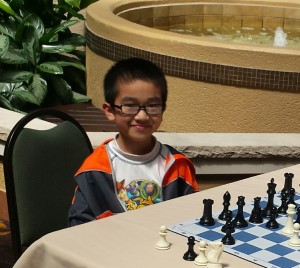
What's the path to becoming a young Grandmaster for a student chess player like 13-year-old almost-grandmaster Samuel Sevian or the top 11 year old in the world Awonder Liang?
Their paths included the recent US Masters Chess Championship in Greensboro, NC over the weekend of Aug 28th-Sept 1st, 2014. Like the similarly named golf tournament, this is an exclusive event for top players, and student players can qualify. But unlike the fabled Augusta, GA golf event, players younger than 18 aren't a novelty. 27 student players competed this year, including the youngest, 8 year old Arthur Guo.
In keeping with the theme of high-achieving students, ChessStream.com put more of the tournament chess pieces on the Internet of Things (IoT) and broadcast more games due to a computer vision innovation developed by a team that included two Western Alamance High School software developers, senior Taylor Hearn and freshman Tobias Fischer.
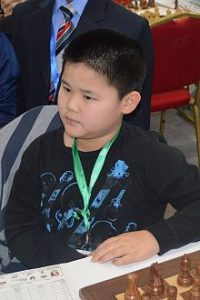
The US Masters Chess Championship attracts top scholastic chess players because it provides the rare opportunity to achieve "norms" or benchmark performances that are necessary to attain the globally recognized International Master (IM) and Grandmaster (GM) titles.
"The requirements for title qualification are very strict and few tournaments in the U.S. provide a norm opportunity," explains Dr. Walter High of the Carolinas Chess Initiative, which ran the championship. "U.S. players often travel to European tournaments for the possibility of attempting a norm. The U.S. Masters, held in Greensboro for the third year, is the only tournament in the southeastern U.S. that even qualifies to offer norms."
Chess tournaments at this level have been broadcast live for a while -- for a recent example at the high end, check out the Sinquefield Cup 2014. It had live broadcasts, play-by-play sports commentary and post game interviews from the likes of GM Maurice Ashley and WGM Jennifer Shahade.
As with much of IoT, the typical way to get the games online is using a sensor approach. When you see a USB cord attached to a chess board, you are probably looking at a DGT board, like the one pictured here. 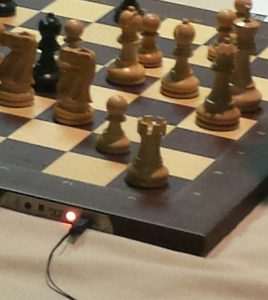 Among a variety of sophisticated features, the DGT setup reads the moves and communicates them in Portable Game Notation (PGN) format, the standard format of chess notation. Chess viewing and analysis software can read it live across the Internet -- no need to wait for the game to complete and for someone to transcribe a player's hand-written record of the game before analysis can begin.
Among a variety of sophisticated features, the DGT setup reads the moves and communicates them in Portable Game Notation (PGN) format, the standard format of chess notation. Chess viewing and analysis software can read it live across the Internet -- no need to wait for the game to complete and for someone to transcribe a player's hand-written record of the game before analysis can begin.
As in previous years, the DGT boards were used for the top four games of each round. This year's innovation was adding a computer vision approach for another handful of games. Instead of a sensor approach that requires special boards and pieces, cameras were pointed at standard tournament sets and software processed the images in to PGN. This innovation could bring a lot more chess online per dollar, and offers lessons not just in the techniques of computer vision, but also in thing-ification economics.
This innovation sprang to life the way so many innovations have over the millennia -- a face-to-face conversation at a gathering that attracted like-minded individuals. "Chacha Nugroho of ChessStream.com approached us at the Robot Rumble held at the Musueum of Life and Science in Durham, N.C. last April about writing some software that would use a camera to track a chess game," said Jochen Fischer, a veteran software developer in the digital imaging field and leader of the Western Alamance High School Robotics Club.
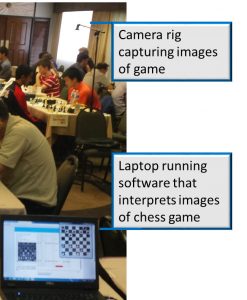 Fischer recruited high schoolers Taylor Hearn and Tobias Fischer to the team and they collaborated on the computer vision coding. The hardware of the system is common and inexpensive -- a regular camera connected to a low-cost laptop which connects over the Internet to the web server that streams the game.
Fischer recruited high schoolers Taylor Hearn and Tobias Fischer to the team and they collaborated on the computer vision coding. The hardware of the system is common and inexpensive -- a regular camera connected to a low-cost laptop which connects over the Internet to the web server that streams the game.
In the future, the laptop could be replaced with another type of cheap computer, such as Raspberry Pi or a smartphone. The computer vision software examines the images and first finds the 64 square chess board. The camera setup doesn't have to be precise because the software can correct the images. 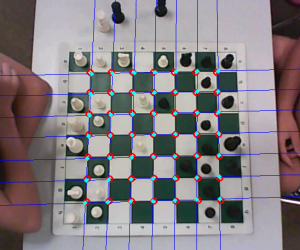 The camera watches the board for the entire game and tracks piece movements. As the pieces move, the PGN of the web view is updated.
The camera watches the board for the entire game and tracks piece movements. As the pieces move, the PGN of the web view is updated.
As chess tournaments are not high-revenue, high-margin events, this approach provides an IoT economics lesson as well. Even if a sensor-laden chess set were exactly the same price as today's standard chess sets, then there is still the question of what to do with the millions of chess pieces currently used at tournaments worldwide. Why revolutionize when you can evolve? Computer vision can connect things to the IoT that can be seen and processed into a meaningful digital form. That's especially valuable for things that can't be easily and cost-effectively embedded with sensors. While passively "seeing" things is most economical on the optical spectrum, passive approaches could thing-ify at other wave lengths as well.
Regardless of how you get a type of thing online, if it's something people are touching, then you are connecting those people to a computer system in a new way. In this case, a chess set can be thought of as a user input device to a computing system. Just like a keyboard is an input device. As a keyboard can have immediate operational effects across many interconnected systems, so could a chess board. Perhaps a game between two young Masters could drive, from half a world away, the human chess pieces of the live human chess game staged in Marostica, Italy every two years. Or, instead of a chess board, it could be some other kind of board designed for a specific business problem, and each move alters operations in some way.
These examples are just a few of the many indications that user interfaces are set to depart radically from the typical keyboard, mouse and screen setup. Instead of just the Internet of Things, it's all manner of connected "Things as Interfaces."
No matter how the chess pieces get online, it means more high-caliber competitive chess content online. Chess has seen broadcast success, like the Fischer-Spasky World Championship match in 1972 that broadcast to millions of American homes. But, those were in the days when mass media was more, well, massive. In today's era, bringing new games online means bringing valued content to a narrower but very interested audience, social media style.
Instead of millions of Cold War television sets, it's about bringing a young player's game to the grandparents' tablets. Or, bringing a top scholastic chess player's game live to a scholastic chess club back home. Just as young baseball players can watch their compatriots in the Little League World Series, so can young chess players. But when you are a grade schooler trying to achieve the highest title in your sport, playing at the U.S. Masters Championship against Grandmaster professionals over twice your age, there is nothing little about it.
Image of Awonder Liang by: chess-db.com // License by: Creative Commons Attribution 1.0 Generic license.

